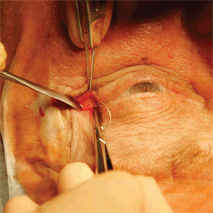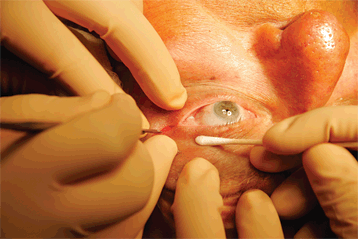8 Lateral Canthopexy

Concentrically arranged fibers of the orbicularis oculi are innervated by cranial nerve (CN) VII to affect narrowing of the palpebral fissure. Palpebral (pretarsal and preseptal) portions of the orbicularis fibers are more involved in involuntary, fine eyelid blink movement, while the orbital portion is responsible for forceful eyelid closure such as in a wink or blepharospasm. Proper eyelid blink dynamics require the palpebral portions of the orbicularis fibers to be firmly anchored at the medial and lateral canthal tendons (LCTs). This provides a tension-bearing anchoring fulcrum for the contracting muscle fibers. Laxity in LCT anchoring renders the concentrically arranged orbicularis fibers ineffective in completing the blink cycle.
Medially, the pretarsal orbicularis has two heads: one forms the anterior limb of the medial canthal tendon (MCT), and the other, deeper head, is the tensor tarsi muscle of Horner forming the posterior limb of the MCT. The lateral palpebral ligament (LCT) is formed by dense fibrous tissue arising from the tarsi and the fusion of the pretarsal orbicularis muscle from the upper and lower eyelids. Laterally, it passes deep to the orbital septum, inserting onto the lateral orbital tubercle 1.5 mm posterior to the lateral orbital rim. The tendon is approximately 10.5 mm in horizontal length and 6.5 mm in vertical width. The midpoint of the LCT at the lateral orbital tubercle measures 10 mm inferior to the frontozygomatic suture line. A small pocket of fat (Eisler pocket) lies between the septum and the LCT. The LCT is also attached to the lateral orbital rim more superficially, through the orbital septum. This superficial fascial plane has been characterized by Knize as the superficial LCT and may be used as a tension-bearing structure to suspend or stabilize the lateral canthus.
LCT disinsertion is a seldom recognized anatomical defect that can alter the mechanics of eyelid blinking and lacrimal pump function. This often results in ocular irritation and epiphora. The clinical features of lateral canthal disinsertion are (a) blunted or vertically displaced lateral canthal angle, (b) medial and inferior movement of the lateral commissure on dynamic eyelid closure, (c) incomplete apposition of the eyelid margins on closure in the absence of anterior lamella shortage, (d) temporal eyelid imbrication on attempted lid closure, and (e) pseudo upper eyelid retraction. Clinically, a cotton-tipped applicator can be used to distract the lateral commissure toward the lateral orbital rim to simulate tightening of the LCT. Improvement in blink dynamics and lid closure with this simple maneuver verify that LCT disinsertion is the underlying anatomical element of pathology. The cotton-tipped applicator test serves as a good predictor of functional outcome following LCT tightening.
The lateral canthopexy technique begins with marking a planned horizontal incision along the lateral canthus. Subcutaneous infiltration of lidocaine 2% with 1:100,000 dilution of epinephrine is administered with a 30-gauge needle. The lateral orbital rim is palpated and a small amount of anesthetic is also delivered to the periosteum of the lateral orbital rim and temporal inferior fornix.

Figure 8-1. A transverse skin incision is made with a No. 15 scalpel blade beginning at the lateral commissure and extends for 1.0 to 1.5 cm toward the lateral orbital rim. Hemostasis is achieved with a bipolar cautery. With fine, shallow movements of the scalpel blade, the circumferential orbicularis muscle fibers are incised.
Stay updated, free articles. Join our Telegram channel

Full access? Get Clinical Tree


